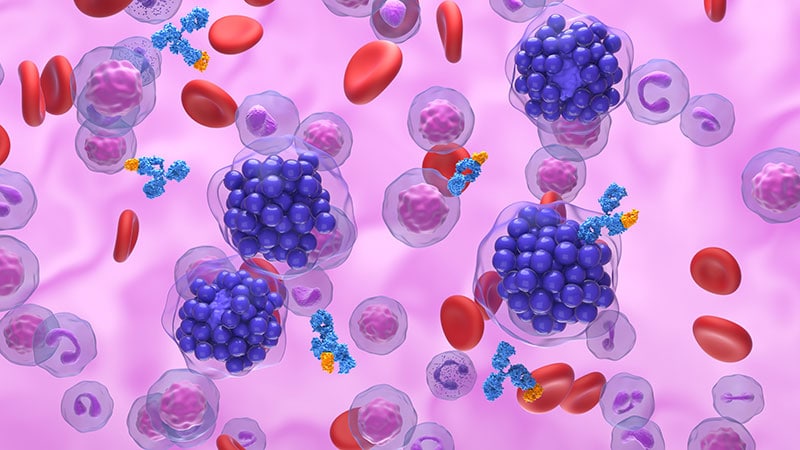While the use of radiation bridging therapy (BT) in chimeric antigen receptor (CAR) T-cell therapy for blood cancer is expanding, plenty of unanswered questions remain on topics such as ideal timing and doses, a radiologist cautioned hematologist colleagues.
The lack of guidelines has immediate clinical implications, said John P. Plastaras, MD, PhD, professor of radiation oncology at the Hospital of the University of Pennsylvania, Philadelphia, in a presentation at 18th International Conference on Malignant Lymphoma (ICML) 2025 in Lugano, Switzerland.
“This actually just came up the other day when one of our medical colleagues said, ‘I’m really worried about this patient. They’re ready for CAR T cell, but I think you need to radiate this area. Can you do it a week after [therapy]?’ The answer is, ‘We don’t know.’”
On the other hand, clinicians now have clarity about safety and interaction with CAR T-cell therapy, he noted, and data is coming in rapidly.
Here are some questions and answers about radiation BT:
What is BT in CAR T-cell therapy?
BT refers to treatment that provides a “bridge” for patients between the components of CAR T-cell therapy.
As a 2024 report about BT in hematologic cancer explained, the treatment “is delivered after leukapheresis for CAR T-cells” — the process in which white cells are removed from a patient’s blood, which is then returned to the body — “has been completed and before lymphodepleting chemotherapy and CAR T-cell infusion.”
The report said “patients who receive BT are predominantly those with a higher disease burden and rapidly progressive disease. These patients tend to have worse overall outcomes, likely related to their aggressive underlying disease.”
Where does radiation fit into BT?
According to the 2024 report, “combination chemoimmunotherapy has typically been the form of BT that is used most often.” Targeted therapy is another option, the report said, although data is from “very small sample sizes.”
And then there’s radiation, which the report said is useful “particularly in patients with limited sites of disease or patients who are at risk for structural complications such as airway compromise or renal dysfunction.”
What do we know about radiation’s efficacy?
The first oral report on bridging radiation in CAR T-cell therapy only appeared in 2018, Plastaras said, followed by the first published report in 2019. Despite this fairly short time period, “we are certainly seeing a lot of new data,” Plastaras said.
He highlighted the newly released International Lymphoma Radiation Oncology Group (ILROG) study of radiation BT in conjunction with CAR T-cell therapy for relapsed/refractory B-cell lymphomas. The retrospective study of 172 patients at 10 institutions treated from 2018 to 2020 showed that 1- and 2-year progression-free survival (PFS) rate was 43% (95% CI, 36-51) and overall survival rate was 38% (95% CI, 30-45).
In a multivariable model, comprehensive radiation BT was linked to superior PFS than focal therapy (hazard ratio, 0.38; 95% CI, 0.22-0.63; P < .001).
“Comprehensive radiation was a very strong predictor for improved PFS, but we did not see was a huge dose effect,” said Plastaras, who coauthored the study.
What about toxicity?
Questions about other clinical matters were resolved prior to 2022, he said, when CAR T-cell therapy was used primarily in third line and later settings.
“Does radiation cause excess toxicities?” he asked. “A lot of the single-institution studies answered that, and I think most medical oncologists and hematologists are okay with this idea that radiation isn’t causing a lot of excess toxicities.”
As for whether radiation interferes with the effectiveness of CAR T-cell therapy, “the data to this point have demonstrated that probably not,” he said. “We’ve probably put that one to bed.”
What do we know about treatment timing?
“The timing question is still quite open,” Plastaras said. “How much time should there be between radiation and lympho-depleting chemotherapy? Is it better to put the radiation very close to the CAR T-cell [therapy] so this priming effect might happen, or can that happen weeks in advance? We don’t know the answers to those.”
According to Plastaras, researchers are still trying to understand the role radiation the consolidation period after CAR T-cell therapy. “If we wait for day-30 PET [scan], is that OK? Do we need to wait longer? Are we going to mess up the lymph nodes that have CAR T-cells floating around in them?”
What about doses and imaging?
There’s also a lack of insight into technical questions about radiation dose and fractionation. “The [radiation] volume question is one of key importance. Do we just do gross disease? Do we treat all the other small spots out there, and importantly, do we treat regional nodes or not? We get these questions all the time.”
The role of imaging is also unclear, he said, in terms of timing during and after bridging radiation therapy and after CAR T-cell therapy.
What do we need to learn about now?
Looking forward, Plastaras outlined what he called “version 2.0” questions for the evolving field: Can radiation rebulking decrease CAR-T cell toxicities? Will very low dose “priming” radiation affect outcomes?
He highlighted other questions: Can radiation be part of a combined modality approach in limited stage relapsed/refractory disease? Should central nervous system lymphoma be treated differently?
When will we get new guidelines?
According to Plastaras, Memorial Sloan Kettering Cancer Center Radiology Oncologist Brandon Imber,MD, MA, in New York City, is leading a new ILROG guideline project with the intention of publishing details in the journal Blood. “This is a work in progress,” Plastaras said. “Our target is 2025 to at least get something submitted.”
Plastaras had no disclosures.
Source link : https://www.medscape.com/viewarticle/radiation-bridging-car-t-where-are-we-now-2025a1000hs7?src=rss
Author :
Publish date : 2025-07-04 08:25:00
Copyright for syndicated content belongs to the linked Source.
